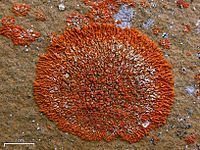
Photo from wikipedia
Background: The common ice plant (Mesembryanthemum crystallinum L.) is an annual herb belonging to the genus Mesembryanthemum of the family Aizoaceae, native to Southern Africa. Methods: We performed shotgun genome… Click to show full abstract
Background: The common ice plant (Mesembryanthemum crystallinum L.) is an annual herb belonging to the genus Mesembryanthemum of the family Aizoaceae, native to Southern Africa. Methods: We performed shotgun genome paired-end sequencing using the Illumina platform to determine the genome sequence of the ice plants. We assembled the whole genome sequences using the genome assembler “ALGA” and “Redundans”, then released them as available genomic information. Finally, we mainly estimated the potential genomic function by the homology search method. Results: A draft genome was generated with a total length of 286 Mb corresponding to 79.2% of the estimated genome size (361 Mb), consisting of 49,782 contigs. It encompassed 93.49% of the genes of terrestrial higher plants, 99.5% of the ice plant transcriptome, and 100% of known DNA sequences. In addition, 110.9 Mb (38.8%) of repetitive sequences and untranslated regions, 971 tRNA, and 100 miRNA loci were identified, and their effects on stress tolerance and photosynthesis were investigated. Molecular phylogenetic analysis based on ribosomal DNA among 26 kinds of plant species revealed genetic similarity between the ice plant and poplar, which have salt tolerance. Overall, 35,702 protein-coding regions were identified in the genome, of which 56.05% to 82.59% were annotated and submitted to domain searches and gene ontology (GO) analyses, which found that eighteen GO terms stood out among five plant species. These terms were related to biological defense, growth, reproduction, transcription, post-transcription, and intermembrane transportation, regarded as one of the fundamental results of using the utilized ice plant genome. Conclusions: The information that we characterized is useful for elucidation of the mechanism of growth promotion under salinity and reversible conversion of the photosynthetic type from C3 to Crassulacean Acid Metabolism (CAM).
Journal Title: F1000Research
Year Published: 2023
Link to full text (if available)
Share on Social Media: Sign Up to like & get
recommendations!